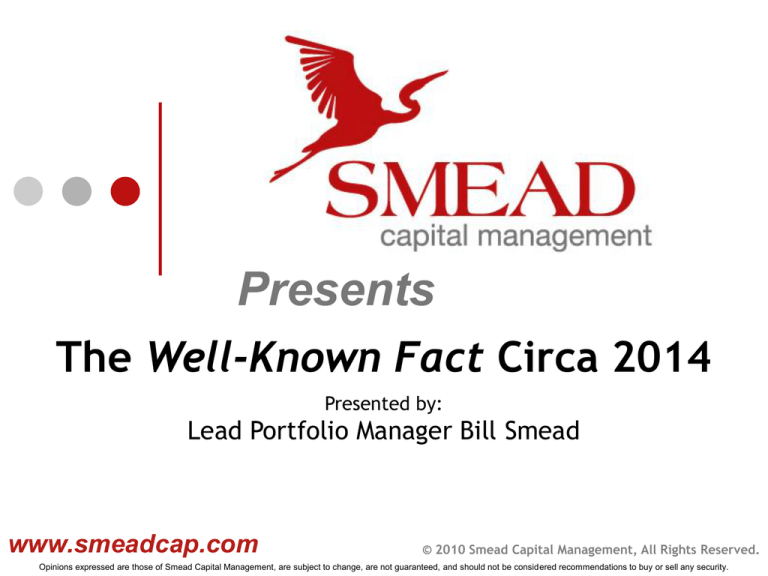
Presents
The Well-Known Fact Circa 2014
Presented by:
Lead Portfolio Manager Bill Smead
www.smeadcap.com
© 2010 Smead Capital Management, All Rights Reserved.
Opinions expressed are those of Smead Capital Management, are subject to change, are not guaranteed, and should not be considered recommendations to buy or sell any security.
The Well-Known Fact Circa 2014
Today’s Agenda
Historical Well Known Facts
Today's Well Known Facts
Unknown Facts
A Virtuous Response to The Well-Known Fact
Circa 2014
The Well-Known Fact Circa 2014
SCM’s Definition
A “Well Known Fact” is defined as a body of
economic information which is not only
known throughout the economy and media,
but has been acted upon by nearly all
market participants. A “Well Known Fact”
and its existence can serve as a contrary
indicator in investment markets.
The Well-Known Fact Circa 2014
Symptoms and Environment
Media sounds the trumpet
Advisors adopt and promote
Historical positive bias (safe speculation)
Multi-year investment success well underway
Identifiable gurus and spokespersons
Loneliness for those not aligned with the Fact
The Well-Known Fact Circa 2014
Tulip Mania of the Dutch Golden Age
Attention came to be concentrated on the possession and display of the
more esoteric of the blooms. And appreciation of the more exceptional of
the flowers rapidly gave way to a yet deeper appreciation of the increase
in the price that their beauty and rarity were commanding. By the mid
1630’s the increase seemed to be without limit.
The rush to invest engulfed the whole of Holland. No person of minimal
sensitivity of mind felt that he could be left behind. Prices were
extravagant; by 1636, a bulb of no previous worth might be exchanged
for “a new carriage, two grey horses and a complete harness (around
$25,000 to $50,000 in today’s dollars).
- John Kenneth Galbraith
Source: A Short History of Financial Euphoria, John Kenneth Galbraith
The Well-Known Fact Circa 2014
Tulip Mania of the Dutch Golden Age
At last, however, the more prudent
began to see that this folly could not
last for ever. Rich people no longer
bought the flowers to keep them in
their gardens, but to sell them again
at cent per cent profit. It was seen
that somebody must lose fearfully in
the end. As this conviction spread,
prices fell, and never rose again.
Confidence was destroyed, and a
universal panic seized upon the
dealers.
- Charles MacKay
Source: Preface to the 1952 Edition of Memoirs of Extraordinary Popular Delusions and the Madness of Crowds, Charles MacKay
The Well-Known Fact Circa 2014
Historical Well Known Facts: Cars, Planes & Radio 1929
The Well-Known Fact Circa 2014
The “Nifty Fifty”: One Decision Stocks
Multiple Compression
Security
Sony
Polaroid
McDonald’s
Intl. Flavors
Walt Disney
Hewlett Packard
Price-Earnings Multiple
1972
Price-Earnings Multiple
1980
92
90
83
81
76
65
17
16
9
12
11
18
Source: Burton Gordon Malkiel, “A Random Walk Down Wall Street”, page 70
The Well-Known Fact Circa 2014
The “Nifty Fifty”: One Decision Stocks
1973-1974: The Nifty-Fifty Bubble Deflates
The S&P 500
(Jan 11, 1973 – Oct 03, 1974)
was down 48%.
The Nifty Fifty fared
much worse.
Coca-Cola (KO)
General Electric (GE)
Avon (AVP)
Source: Bloomberg; Big Charts
Past performance does not guarantee future results.
Disney (DIS)
The Well-Known Fact Circa 2014
Oil, Gold and Bonds, early 1980’s
Source: http://inflationdata.com/Inflation/images/charts/Oil/Gasoline_inflation_chart.htm
The Well-Known Fact Circa 2014
Oil, Gold and Bonds, early 1980’s
Source: http://inflationdata.com/articles/charts/inflation-adjusted-annual-average-gold-prices/
The Well-Known Fact Circa 2014
Oil, Gold and Bonds, early 1980’s
10-Year Treasury Yields: Jan 1962 through April 2014
Source: Yahoo! Finance chart - CBOE Interest Rate 10-Year T-No (^TNX) from Jan 2, 1962 through Apr 1, 2014
The Well-Known Fact Circa 2014
Japan and Japanese Stocks, late 1980’s
Source: ThomsonReuters Baseline
The Well-Known Fact Circa 2014
Japan and Japanese Stocks, late 1980’s
“Tokyo land valuations
had soared to the point
where it was calculated
that the site of the
imperial palace, near
the centre of the city,
was worth more than
all the real estate in
California”
-Telegraph UK
Source (graphic) - “That’s Not How Bubbles Work” by www.huffingtonpost.com on July 20, 2009
Source (quote) - Telegraph UK “Oriental risks and rewards for optimistic occidentals” Aug 7, 2004
The Well-Known Fact Circa 2014
Savings and Loan debacle 1987-1992
Source: thewealthsteward.com “U.S. bank failures lag economic & stock market bottoms” Aug 24, 2010
The Well-Known Fact Circa 2014
Savings and Loan debacle 1989-1991
Source: Bloomberg
The Well-Known Fact Circa 2014
“The Internet Will Change Your Life” / “New Economy”
Source: Bloomberg
The Well-Known Fact Circa 2014
Real-Estate / Credit Bubble 2003-2010
Source: Redfin Seattle Sweet Digs “Case-Shiller: Seasonal Home Price Bump Turns Flat in May” July 28, 2009
The Well-Known Fact Circa 2014
The Well-Known Fact Circa 2014
Featured Stock: Bank of America
Historical Well Known Facts
Today's Well Known Facts
Unknown Facts
A Virtuous Response to The Well-Known
Fact Circa 2014
The Well-Known Fact Circa 2014
“Once a price history develops, and people hear that
their neighbor made a lot of money on something, that
impulse takes over, and we're seeing that in
commodities and housing...Orgies tend to be wildest
toward the end. It's like being Cinderella at the ball.
You know that at midnight everything's going to turn
back to pumpkins & mice. But you look around and say,
'one more dance,' and so does everyone else. The party
does get to be more fun -- and besides, there are no
clocks on the wall. And then suddenly the clock strikes
12, and everything turns back to pumpkins and mice.”
- Warren Buffett
Source: CNN Money article “Buffett: Real estate slowdown ahead” by Jason Zweig of May 8, 2006
The Well-Known Fact Circa 2014
Today’s Well-Known Fact
The Well-Known Fact Circa 2014
Today’s Well-Known Fact: Wide Diversification
Note: alternative strategies include private equity (LBOs, mezzanine, M&A funds and international private equity); marketable
alternatives (hedge funds, absolute return, market neutral, long/short, 130/30, event-driven and derivatives); venture capital; private
equity real estate (non-campus); energy and natural resources (oil, gas, timber, commodities and managed futures); and distressed
debt
Past Performance does not Guarantee Future Returns
Source: NACUBO-Commonfund public NCSE information
The Well-Known Fact Circa 2014
Today’s Well-Known Fact: Lower Domestic Exposure
Past Performance does not Guarantee Future Returns
Source: http://www.top1000funds.com/news/2011/09/28/harvard-favours-emerging-markets-and-absolute-returns-over-fixed-income/
The Well-Known Fact Circa 2014
Today’s Well-Known Fact: Emerging Markets a Must Own
Past Performance does not Guarantee Future Returns
Source: White Paper “Asset Allocation at Barclays”, March 2013, Page 14
The Well-Known Fact Circa 2014
Today's Well Known Facts: Small-Caps Deserve Big Premiums!
Source: Merrill Lynch “(Mid-) Year Ahead in Pictures”, page 92
The Well-Known Fact Circa 2014
Today’s Well-Known Fact: Buy Hard-Assets
Past Performance does not Guarantee Future Returns
Source: Merrill Lynch report “Just in case rates don’t rise…”, chart 1 page 1
The Well-Known Fact Circa 2014
Today’s Well-Known Fact: Oil Drilling Frenzy
Past Performance does not Guarantee Future Returns
Source: Fidelity Investments Institutional – Investment Themes for 2014, page 12
The Well-Known Fact Circa 2014
Today’s Well-Known Fact: The U.S. is Unattractive
Source: http://video.cnbc.com/gallery/?video=3000099730
The Well-Known Fact Circa 2014
Today’s Well-Known Fact: The New Normal/Neutral
Source: http://www.pewresearch.org/fact-tank/2013/10/18/millennials-still-lag-in-forming-their-own-households/
The Well-Known Fact Circa 2014
Today’s Well-Known Fact: Passive Investing
Past Performance does not Guarantee Future Returns
Source: 2014 Investment Company Fact Book
The Well-Known Fact Circa 2014
Today’s Well-Known Fact: ETF Panacea
Past Performance does not Guarantee Future Returns
Source: 2014 Investment Company Fact Book
The Well-Known Fact Circa 2014
The Well-Known Fact Circa 2014
Featured Stock: Bank of America
Historical Well Known Facts
Today's Well Known Facts
Unknown Facts
A Virtuous Response to The Well-Known
Fact Circa 2014
The Well-Known Fact Circa 2014
Keynes on Well-Known Facts
“It [investing] is the one sphere of life and activity
where victory, security and success is always to the
minority and never to the majority. When you find any
one agreeing with you, change your mind. When I can
persuade the Board of my Insurance Company to buy a
share, that, I am learning from experience, is the right
moment for selling it.”
- John Maynard Keynes
Source: http://www.maynardkeynes.org/keynes-the-investor.html
The Well-Known Fact Circa 2014
Unknown Facts: U.S. Households are in Great Shape
% (Percent)
Source: Bloomberg
Federal Reserve US Financial Obligations Ratio - An estimate of the ratio of debt payments to
disposable income. The types of debt included in the financial obligation ratio include mortgage
payments, credit cards, property tax and lease payments.
The Well-Known Fact Circa 2014
Unknown Facts:
New Era of Regulation and Litigation for Banks
Source: WSJ article “BofA in Talks to Pay At Least $12 Billion to Settle Probes”, June 5, 2014
The Well-Known Fact Circa 2014
Unknown Facts: U.S. Banks at Historically Low Stress Levels
St Louis Fed Financial Stress Index
(Ticker: STLFSI / SLF FSI):
This Index measures the degree
of financial stress in the
markets and is constructed
from 18 weekly data series:
seven interest rate series, six
yield spreads and five other
indicators. Values below zero
suggest below-average financial
market stress, while values
above zero suggest aboveaverage financial market stress.
Past performance does not guarantee future results.
Source: Bloomberg
The Well-Known Fact Circa 2014
Unknown Facts: Housing is Very Affordable
To interpret the indices, a value of 100 means that a family with the median
income has exactly enough income to qualify for a mortgage on a medianpriced home. An index above 100 signifies that family earning the median
income has more than enough income to qualify for a mortgage loan on a
median-priced home, assuming a 20 percent down payment.
Source: Bloomberg
The Well-Known Fact Circa 2014
Unknown Facts: Housing Starts/Supply Coming Off Record Lows
Number of new housing units started in the U.S.,
annually, In Thousands
Source: Bloomberg
The Well-Known Fact Circa 2014
Unknown Facts: Housing has Leverage to the Economy
Residential fixed investment includes the construction of new single-family
and multi-family houses, manufactured housing (or mobile homes) and
home improvements. Also included in residential fixed investment are the
brokers’ commissions on sales, net purchases of used structures and
residential equipment.
Source: http://www.bespokeinvest.com/thinkbig/2014/4/23/housing-and-economic-growth.html
The Well-Known Fact Circa 2014
Unknown Facts: Low Interest Rates Likely to Rise Slowly
Source: http://online.barrons.com/news/articles/SB50001424053111903409104579517663810941986
The Well-Known Fact Circa 2014
Unknown Facts: Gorgeous Demographics
Developed economies are about to experience a baby boom that will be bigger and longer-lasting than
even the one that followed the Second World War.
The entry of the Millennial generation into their prime childbearing years, along with the recouping of
births that were postponed both due to the recession and by the decision of many women to delay
having children until their thirties, will drive the first leg of this new baby boom
Continued progress in creating more family-friendly labor market institutions in developed economies,
increased gender equality, rising incomes, as well as cultural and possibly genetically-driven shifts in the
composition of populations towards more fecund individuals will all power the second leg of the baby
boom.
Faster population growth implies stronger aggregate demand in the near term and more rapid supply
growth over the long haul. Equities, housing, and commodities should benefit.
Properly measured, U.S. fertility rates are already well above the baseline used by the government in
projecting future fiscal trends. Our estimates imply a fiscal surplus of 4% of GDP by the end of the
century, even if current entitlement programs are not scaled back.
- The Bank Credit Analyst, September 2013
Source: The Bank Credit Analyst, September 2013 “The Coming Baby Boom in Developed Economies”
The Well-Known Fact Circa 2014
Unknown Facts: Underinvested & Risk-Averse
Source: MarketWatch / Howard Gold article “Not even a bull market can interest people in stocks”, June 8, 2014
The Well-Known Fact Circa 2014
Unknown Facts: Underinvested & Risk-Averse
Source: http://mjperry.blogspot.com/2012/04/2011-most-energy-efficient-economy-in.html
The Well-Known Fact Circa 2014
The Well-Known Fact Circa 2014
Featured Stock: Bank of America
Historical Well Known Facts
Today's Well Known Facts
Unknown Facts
A Virtuous Response to The Well-Known
Fact Circa 2014
The Well-Known Fact Circa 2014
A Virtuous Response to The Well-Known Fact
Flee the Area
Buy what is undervalued because of
the massive capital misallocation
Show immense patience
The Well-Known Fact Circa 2014
A Virtuous Response: Flee The Area
10-year smoothed commodity price growth may
be peaking within widening amplitude
1795
to first
Apr-2,
10-yr.
M.A. April 2, 2014
Data going backData
to 1795,
with
data2014
point(TTM),
12/31/1805
– through
15%
U.S.$
debasement,
EM growth
14%
Cold War
(1980 peak)
13%
12%
11%
World War 1
(1920 peak)
10%
9%
7%
6%
5%
World War 2,
Korean Conflict
U.S.Civil War
(1864 peak)
8%
War of 1812 &
Napoleonic Wars
(1814 peak)
4%
3%
2%
1%
0%
-1%
-2%
-3%
-4%
-5%
2025E
2015E
2005
1995
1985
1975
1965
1955
1945
1935
1925
1915
1905
1895
1885
1875
1865
1855
1845
1835
1825
1815
1805
-6%
PPI All Commodities (Up to 1956) and CRB Commodity Futures (1957-now) Linked Commodity Prices Y/Y % Change, 10-Yr. Moving Average
Source: Commodities 1795 to 1890 are the Warren & Pearson index constructed with farm products, foods, hides & leather, textiles, fuel & lighting, metals & metal products, building
materials, chemicals & drugs, household furnishing goods, spirits and other commodities. 1891 to 1913 is the Wholesale Commodities Price Index from the BLS and other agencies.
1914 to 1956 is the PPI for All Commodities, and 1957 to present is the CRB CCI Index.
Past Performance is not a guarantee of future results
Source: Stifel Nicolaus / Barry Bannister April 2, 2014
The Well-Known Fact Circa 2014
A Virtuous Response: Buy Into Capitulation and Fear
Source: Bloomberg
The Well-Known Fact Circa 2014
A Virtuous Response: Flee The Area
MSCI EM (Ticker MXEF) Index: The Morgan
Stanley Capital Emerging Markets Index is
a free float weighted equity index.
MSCI EAFE (Ticker MXEA) Index: The MSCI EAFE
Index is a free-float weighted equity
index. The index was developed with a
base value of 100 as of December 31
1969. The MSCI EAFE region covers DM
countries in Europe, Australasia, Israel,
and the Far East.
S&P 500 (Ticker SPX) Index: Standard and Poor's
500 Index is a capitalization-weighted
index of 500 stocks. The index is designed
to measure performance of the broad
domestic economy through changes in the
aggregate market value of 500 stocks
representing all major industries. The
index was developed with a base level of
10 for the 1941- 43 base period.
Source: Bloomberg
The Well-Known Fact Circa 2014
A Virtuous Response: Recognize Capital Misallocation
Source: http://online.wsj.com/news/articles/SB10001424052702304819004579489033376330174
The Well-Known Fact Circa 2014
A Virtuous Response: Recognize Capital Misallocation
Source: http://online.wsj.com/news/article_email/private-equity-has-more-than-it-can-spend-1402670650lMyQjAxMTA0MDEwODExNDgyWj
The Well-Known Fact Circa 2014
A Virtuous Response: See the Opportunity
Source: Business Insider – Markets Chart Of The Day “Here Come America’s 23-Year-Olds, June 18, 2014
The Well-Known Fact Circa 2014
A Virtuous Response: Recognize A Cheap U.S. Dollar
Source: Bloomberg
The Well-Known Fact Circa 2014
A Virtuous Response: Buy Into Capital Misallocation
Past performance does not guarantee future results.
Source: Merrill Lynch “(Mid-) Year Ahead in Pictures”, page 87
The Well-Known Fact Circa 2014
A Virtuous Response: Buy High Quality Stocks
Source: Bloomberg
The Well-Known Fact Circa 2014
A Virtuous Response: Show Immense Patience
Source: http://www.ritholtz.com/blog/2013/07/historical-returns-by-holding-period/
The Well-Known Fact Circa 2014
The Well-Known Fact Circa 2014
Featured Stock: Bank of America
Historical Well Known Facts
Today's Well Known Facts
Unknown Facts
A Virtuous Response to The Well-Known
Fact Circa 2014
Definitions
S&P 500 Index: A market-value weighted index consisting of 500 stocks chosen for market size, liquidity, and
industry group representation.
Russell 1000 Value Index (R 1000 Value): A measure of the performance of those Russell 1000 companies with
lower price-to-book ratios and lower forecasted growth values. One cannot invest directly in an index.
Free Cash Flow (FCF): measures the cash generating capability of a company by adding non-cash charges (e.g.
depreciation) and interest expense to pretax income.
Book Value: is the net asset value of a company, calculated by subtracting total liabilities from total assets.
Price / Book ratio: current price / most recent book value per share.
Long Term Debt (L/T Debt): Loans with obligations of over one year on which interest is paid.
Basis point (bps): A unit that is equal to 1/100th of 1% and is used to denote the change in a financial instrument.
Earnings Stability (R2): R2 measures the deviation of a company's earnings from its historical earnings growth rate.
Earnings per share (EPS): is calculated by taking the total earnings divided by the number of shares outstanding.
Return on Equity (ROE): ROE is equal to a fiscal year's net income (after preferred stock dividends but before
common stock dividends) divided by total equity (excluding preferred shares), expressed as a percentage.
Cash Flow: A revenue or expense stream that changes a cash account over a given period.
Net Profit Margin (NPM): Earnings divided by revenue.
Earnings Stability: The complement of the standard deviation of annual earnings from those which would be plotted
on reconstructed regression slope lines determined by the stock's annual rate of growth of earnings.
P/E Rel to 10 Year Average: The price/earnings ratio of the trailing 12-month period, compared to the average
price/earnings ratio of the last 10-years for a security
MSCI Emerging Markets Index (notated as “EM”): An index created by Morgan Stanley Capital International (MSCI)
that is designed to measure equity market performance in global emerging markets.
Definitions (cont.)
Russell 2000 Index: The Russell 2000 serves as a benchmark for small-cap stocks in the United States.
Beta: A measure of the volatility, or systematic risk, of a security or a portfolio in comparison to the market as a
whole. Beta is used in the capital asset pricing model (CAPM), a model that calculates the expected return of an
asset based on its beta and expected market returns.
Sharpe Ratio: A risk-adjusted measure developed by William F. Sharpe, calculated using standard deviation and
excess return to determine reward per unit of risk. The higher the Sharpe ratio, the better the fund's historical riskadjusted performance.
Debt / Equity Ratio: A measure of a company's financial leverage calculated by dividing its total liabilities by
stockholders' equity. It indicates what proportion of equity and debt the company is using to finance its assets.
$ Average Market Cap: the average Market Capitalization of a portfolio/universe, weighted by the dollars invested
in the respective companies; Market Capitalization is the total dollar market value of all of a company’s outstanding
shares, calculated by multiplying a company’s shares outstanding by the current market price of one share
Household Debt Service Ratio: the Household Debt Service Ratio is an estimate of the ratio of debt payments to
disposable personal income. Debt payments consist of the estimated required payments on outstanding mortgage
and consumer debt.
“Nasdaq” is Nasdaq Composite: A market-capitalization weighted index of the more than 3,000 common equities
listed on the Nasdaq stock exchange.
Brazil Bovespa Index: The Bovespa Index (IBovespa) is the main indicator of the average performance of the
BM&FBovespa exchange. The IBovespa covers more than 80% of the trades and approximately 70% of the market
capitalization of the exchange.
Russian RTS Index: The Russian RTS Index is a capitalization-weighted index of 50 Russian stocks traded on the
Moscow Exchange in Moscow, Russia. The list of stocks is reviewed every three months by the RTS Information
Committee.
Definitions (cont.)
India BSE Sensex Index: The S&P BSE Sensex Index is a cap-weighted index. The index members have been selected
on the basis of liquidity, depth, and floating-stock-adjustment depth and industry representation. Sensex has a base
date and value of 100 in 1978-1979.
Shanghai SE Comp Index: The Shanghai Stock Exchange Composite Index is a capitalization-weighted index. The
index tracks the daily price performance of all A-shares and B-shares listedon the Shanghai Stock Exchange. The
index was developed on December 19, 1990 with a base value of 100.
CRB Index: The CRB Index is a measure of price movements of 22 sensitive basic commodities whose markets are
presumed to be among the first to be influenced by changes in economic conditions. indu
Dow Jones 30 Index (Dow Jones Industrial Average): The Dow Jones Industrial Average is a price-weighted average
of 30 blue-chip stocks that are generally the leaders in their industry. It has been a widely followed indicator of the
stock market since October 1, 1928.
NASDAQ Biotech Index: The NASDAQ Biotechnology Index is a modified market capitalization-weighted index
designed to measure the performance of all NASDAQ stocks in the biotechnology sector.
Price/Earnings (Trailing): the ratio of a firm’s closing stock price & its trailing 12 months’ earnings/share.
Price/Earnings (Forward): the ratio of a firm’s closing stock price & its forward expected 12 months’
earnings/share.
Enterprise Value: The sum of Market Capitalization, Preferred Equity, and short- and long-term interest-bearing
debt, less cash and equivalents. Used as a proxy for the takeover value of a firm.
EBITDA: Used as a proxy for Operating Earnings. EBITDA is earnings before taxes, depreciation, and amortization
Ent Value / Ebitda: A ratio with Enterprise Value as numerator, and EBITDA as denominator.
Alpha: Alpha is the excess return of a fund relative to the return of its benchmark.
Disclosures
The fund's investment objectives, risks, charges and expenses must be considered
carefully before investing. The summary and statutory prospectuses contain this and
other important information about the investment company, and it may be obtained
by calling 877-807-4122 or visiting www.smeadfunds.com. Read it carefully before
investing.
Mutual fund investing involves risk. Principal loss is possible. The Fund is nondiversified, meaning it may concentrate its assets in fewer individual holdings than
a diversified fund. Therefore, the fund is more exposed to individual stock
volatility than a diversified fund.
The Smead Value Fund is distributed by Quasar Distributors, LLC.
Questions & Answers









